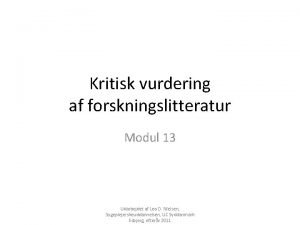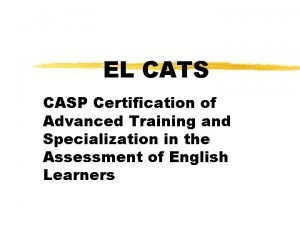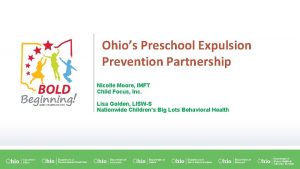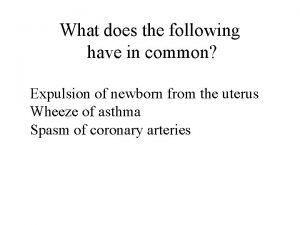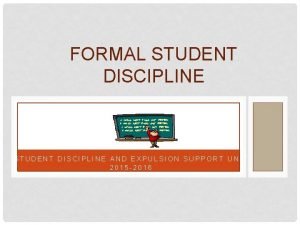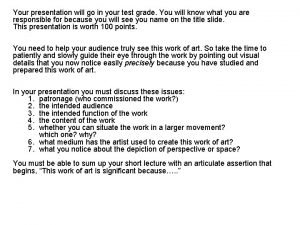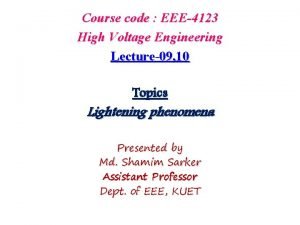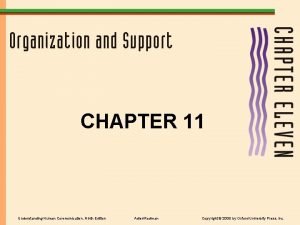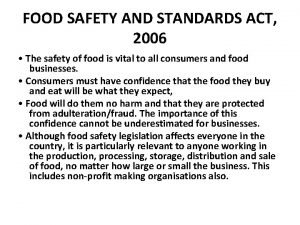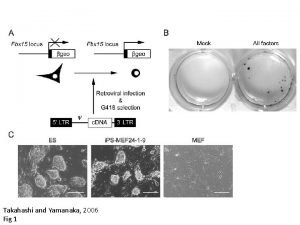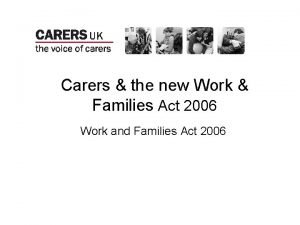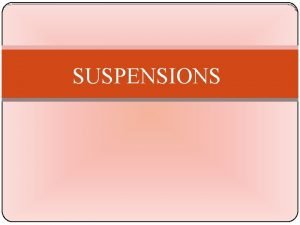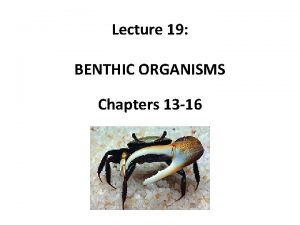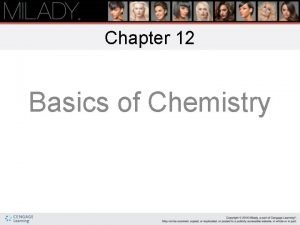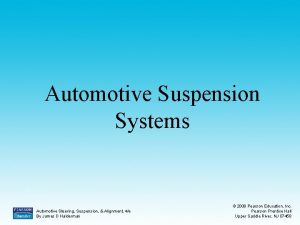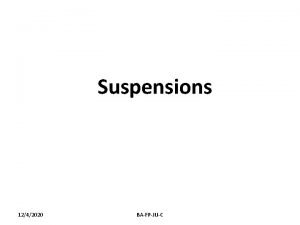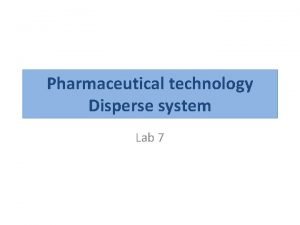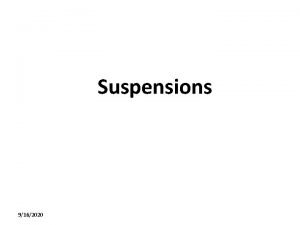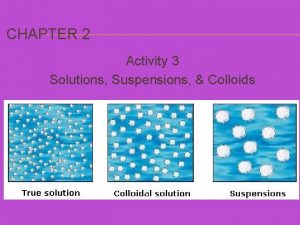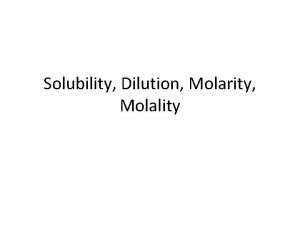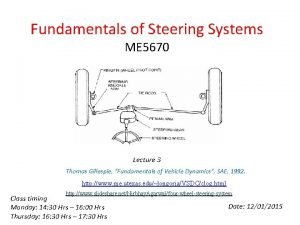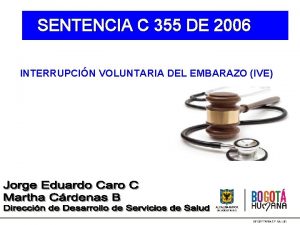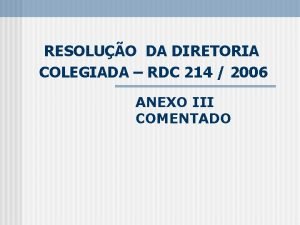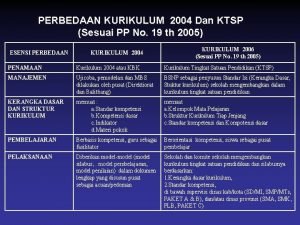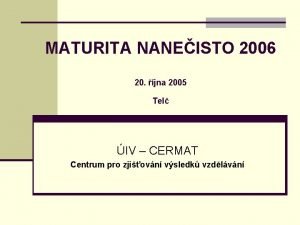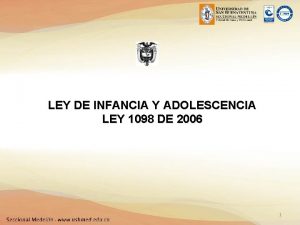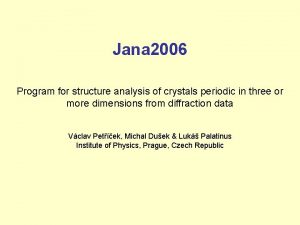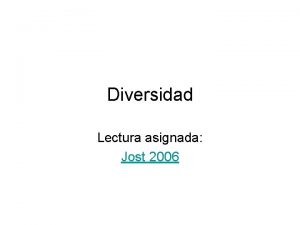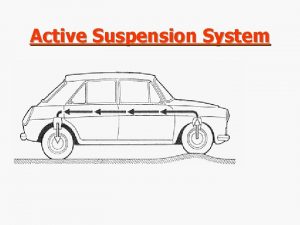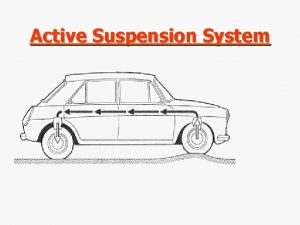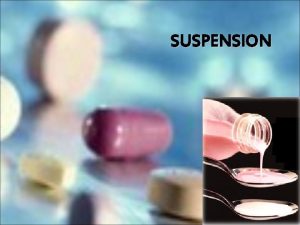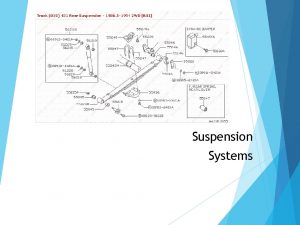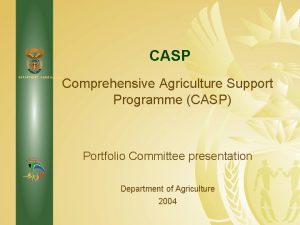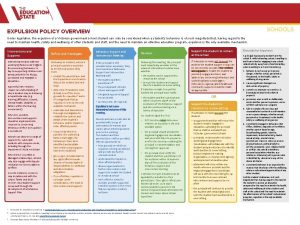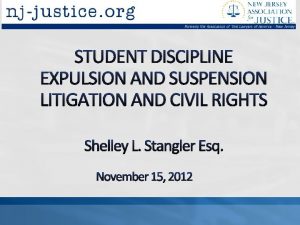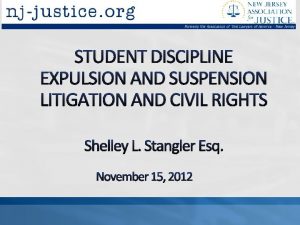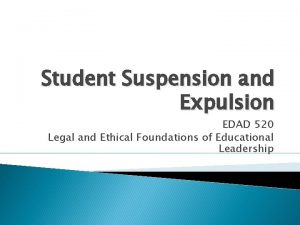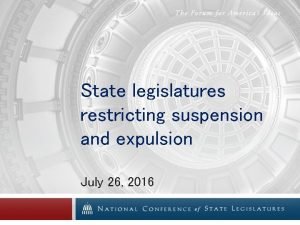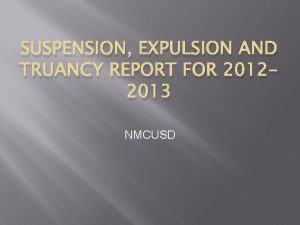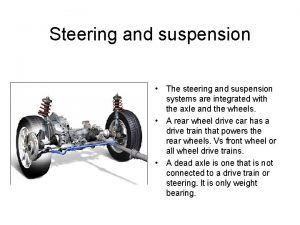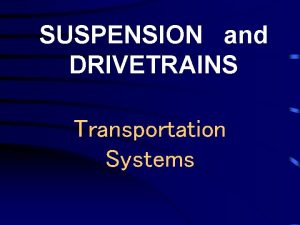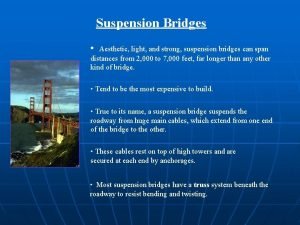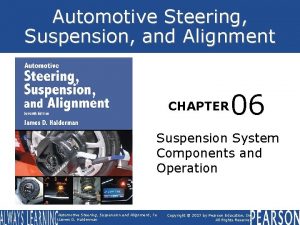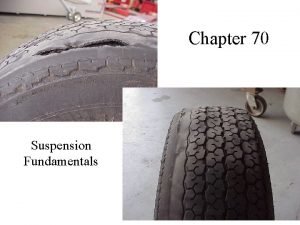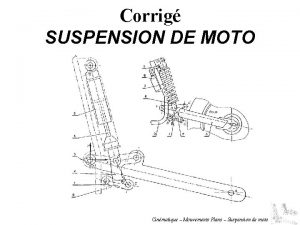CASP 2006 Suspension and Expulsion What Every School







































































- Slides: 71

CASP 2006 Suspension and Expulsion: What Every School Psychologist Needs to Know Randy Fall, Ph. D. , Azusa Pacific University Ray Vincent, M. Miss. , Consultant, Los Angeles County Office of Education Rob Jacobsen, Esq. , Consultant, Los Angeles County Office of Education David R. Morrison, Ed. D. , Azusa Pacific University 11/3/2020 1

CASP 2006: Suspension and Expulsion Has “zero-tolerance” made schools safer? Schools have always been relatively safe places. They were safe prior to “zero tolerance”, and they remain safe after “zero tolerance. ” 11/3/2020 2

CASP 2006: Suspension and Expulsion No evidence that exclusion - changes student behavior - improves student outcomes Evidence that exclusion - increases dropout rates - increases rates of disruption (Council for Children with Behavior Disorders, June, 2002) 11/3/2020 3

CASP 2006: Suspension and Expulsion Wagner (1991) reported that 74% of SED students who drop out are arrested within five years of dropping out. Hodgkinson (1995) reported that 82% of persons in state and local prisons are high school drop outs. 11/3/2020 4

CASP 2006: Suspension and Expulsion n In 1994, the term zero tolerance assumed new significance when President Clinton signed into law the Gun Free Schools Act. This law required that all states that receive federal funds have in effect a state law requiring all local education agencies in the state to expel from school for a period of not less than one year any student who was found to have brought a weapon to school. 11/3/2020 5

CASP 2006: Suspension and Expulsion Which of these is a weapon? Tweety Bird Keychain Chicken finger Rubber band paper clip Nail Clipper 11/3/2020 6

CASP 2006: Suspension and Expulsion Which of these is a weapon? Chicken finger A. B. Tweety Bird Keychain C. Rubber band D. Nail Clipper 11/3/2020 7

CASP 2006: Suspension and Expulsion Which of these is a weapon? Chicken finger n Christopher Kissinger, an 8 -year-old first-grader at South Elementary School in Jonesboro, AR was suspended from school for 3 days in January, 2001 for aiming a chicken strip toward a teacher and saying, “Pow, pow” (The Associated Press State & Local Wire, 2001). Tweety Bird Keychain n ACLU of Georgia represents student suspended from school for carrying “Tweety Bird” key chain. Available at www. aclu. org/news/2000/n 100200. html. See also Georgia girl’s Tweety Bird chain runs afoul of weapons policy. Available at http: //www. cnn. com/2000/US/09/28/wallet. suspension. 02/. 11/3/2020 8

CASP 2006: Suspension and Expulsion Student brings a gun catalog to school 8 th grader Has a heart ailment that prevents him from participating at recess or PE. Brought it to read Principal wants your recommendation about discipline 11/3/2020 9

CASP 2006: Suspension and Expulsion Student brings a gun catalog to school The catalog turns out to be a BB gun catalog The guns are realistic-looking BB guns from Taiwan – e. g. , looks like an AK 47. You interview the student: Owns one BB gun, shoots targets in his cousin’s back yard Says he doesn’t ever shoot at people No apparent fascination with guns Never has brought his BB gun to school Brought the catalog as something to look at. Didn’t show it to anyone else No prior behavior incidents 11/3/2020 10

CASP 2006: Suspension and Expulsion n Assumption that school is a reinforcing environment, therefore, remove the reinforcement, reduce the behavior If school is a punishing environment, suspension and expulsion maintain and increase the behavior Not an immediate reinforcer, requires thought and reflection. Example, “I hope nothing happens today. ” 11/3/2020 11

n n n Mandatory Expulsion (Education Code 48915(c)) Act must be committed at school or school activity. Firearm Possessing firearm when a district employee verified firearm possession and when student did not have prior written permission from a certificated employee which is concurred with by the principal or designee. Selling or otherwise furnishing a firearm ¨ Brandishing a knife at another person. ¨ n n n Unlawfully selling a controlled substance listed in Health and Safety Code Section 11053 et. seq. Committing or attempting to commit a sexual assault as defined in subdivision (n) of 48900 or committing sexual battery as defined in subdivision (n) of 48900. Possession of an explosive. 11/3/2020 12

Expulsion Expected n n n must be committed at school or school activity. Education Code Section 48915 (a) states that an administrator shall recommend expulsion for the following violations [except for subsections (c) and (e)] unless the administrator finds that expulsion is inappropriate due to a particular circumstance. Causing serious physical injury to another person, except in selfdefense. Education Code Section 48915 (a)(1). Possession of any knife, explosive, or other dangerous object of no reasonable use to the pupil. Education Code Section 48915 (a)(2). Possession and/or use of any substance listed in Chapter 2 (commencing with Section 11053) of Division 10 of the Health and Safety Code, except for the first offense for possession of not more than one avoirdupois ounce of marijuana other than concentrated cannabis. 11/3/2020 13

Expulsion Expected n n n Robbery or extortion. Education Code Section 48915 (a)(4). Assault or battery, or threat of, on a school employee. The recommendation for expulsion shall be based on one or both of the following: ¨ Other means of correction are not feasible or have repeatedly failed to bring about proper conduct. ¨ Due to the nature of the act, the presence of the pupil causes a continuing danger to the physical safety of the pupil or others [see Section 48915 (b)]. 11/3/2020 14

Discretionary n n n Acts committed at school or school activity or on the way to and from school or school activity Inflicted physical injury† Possessed dangerous objects Possessed drugs or alcohol (policy determines which offense) Sold look alike substance representing drugs or alcohol Committed robbery/extortion Caused damage to property‡ Committed theft Used tobacco (policy determines which offense) Committed obscenity/profanity/vulgarity Possessed or sold drug paraphernalia 11/3/2020 15

Discretionary (continued) n n n n n Disrupted or defied school staff Received stolen property Possessed imitation firearm Committed sexual harassment Harassed, threatened or intimidated a student witness Sold prescription drug Soma Committed hazing The recommendation for expulsion shall be based on one or both of the following: Other means of correction are not feasible or have repeatedly failed to bring about proper conduct. Due to the nature of the act, the presence of the pupil causes a continuing danger to the physical safety of the pupil or others [see Section 48915 (b)]. 11/3/2020 16

Case #1 Student brings a tiny toy gun to school 11/3/2020 17

Case #2 Student brings a gun catalog to school 8 th grader Has a heart ailment that prevents him from participating at recess or PE. Brought it to read Principal wants your recommendation about discipline 11/3/2020 18

Case #3 Student brings a slingshot to school 4 th grader no discipline history brought it to show his friends 11/3/2020 19

CASP 2006: Suspension and Expulsion Laws Governing Suspension and Expulsion n Safe School Guarantee "Students and staff of public schools have the inalienable right to attend campuses that are safe, secure, and peaceful. " (California Constitution, Article I, Section 28) n California Education Code Chapter 6. Pupil Rights and Responsibilities Article 1. Suspension and Expulsion Sections 48900 through 48927 11/3/2020 20

CASP 2006: Suspension and Expulsion Select Education Code Provisions n 48900 Grounds for suspension or expulsion (48900. 2 -48900. 7) n 48911 Suspension n 48915 Expulsion, particular circumstances n 48915. 5 Expulsion of pupils with exceptional needs n 48918 Rules governing expulsion procedures 11/3/2020 21

CASP 2006: Suspension and Expulsion Suspension from School (48911) n n n Principal, principal's designee, or the superintendent authorized Requires 48900(a-s) violation Preceded by informal conference with student Maximum of five consecutive school days Applicable to both regular and special education students (48900. 5) Imposed only when other interventions fail (48900. 5) 11/3/2020 22

CASP 2006: Suspension and Expulsion n Principal or the superintendent recommends n Permissive recommendation and permissive order (48915) n Mandatory recommendation and mandatory order (48915) n Mandatory recommendation and permissive order (48915) n Local rules and regulations (48918) n Hearing rights (48918) n Substantial evidence standard (48918) 11/3/2020 23

CASP 2006: Suspension and Expulsion Special Needs Pupils n Education Code Section 48915. 5 n Title 20 USC Section 1415(k) n Title 34 CFR Sections 300. 519 through 300. 529 n Behavior interventions n Manifestation determination and placement review 11/3/2020 24

CASP 2006: Suspension and Expulsion Preparation for Expulsion (the first five days) n Review the file ¨ Appropriate Behavior Assessments ¨ Appropriate Academic Assessment ¨ Date of the last psychoeducational assessment ¨ If the psycho-evaluation is more than 2 years old, you should do a new, appropriate assessment ¨ May need academic and/or social-emotional assessment 11/3/2020 25

CASP 2006: Suspension and Expulsion Preparation for Expulsion (the first five days) Check to see if there is a current Behavior Intervention Plan (BIP) in place for this or any other type of behavior problems n In most cases, you cannot go forward without it n 11/3/2020 26

CASP 2006: Suspension and Expulsion Preparation for Expulsion (the first five days) Responsibilities of the school psychologist: ¨ Conversation with Parents ¨ Conversation with General Ed. Teacher ¨ Conversation with Special Education Teacher ¨ Conversation with Site Administrator ¨ Conversation with the District Administrator 11/3/2020 27

CASP 2006: Suspension and Expulsion Preparation for Expulsion (the first five days) Tips for working with Parents n n n n Prior involvement with the parent Talk with a smile on your face Listen to their side of the story Ask questions in a non-accusatory manner Don’t argue with them Don’t give the school’s side of the story if you know it Act as a student advocate 11/3/2020 28

CASP 2006: Suspension and Expulsion Preparation for Expulsion (the first five days) Tips for working with Parents n n n If they say that they want a lawyer, tell them that they can have one, but would they consider waiting until you have investigated the incident and presented a solution to the problem Main Emphasis: Try to de-escalate their anger/frustration if they show this Summary: Clarify what you have heard by paraphrasing the essence of their story 11/3/2020 29

CASP 2006: Suspension and Expulsion Preparation for Expulsion (the first five days) Working with General Education and Special Education teachers n n Follow the points listed in the previous slide with parents Find out the teacher’s perspective on the students current history of behavior and academic success. Obtain the latest academic testing results (W-J, etc. ) If necessary, have them re-assess them with W-J or equivalent. 11/3/2020 30

CASP 2006: Suspension and Expulsion Preparation for Expulsion (the first five days) Working with School Administrators n n n Follow the points listed in the Parent Slide Try to determine what outcomes the Admin. Wants Work with the Admin. and let them know that you want to do what is best for the student and the school 11/3/2020 31

CASP 2006: Suspension and Expulsion Preparation for Expulsion (the first five days) ¨ Conversation with the District Administrator who will be conducting the meeting Review the case n Communicate the findings n 11/3/2020 32

CASP 2006: Suspension and Expulsion Preparation for Expulsion (the first five days) n Before you go to the manifestation determination meeting, make sure you have: ¨ Addendum page ¨ Manifestation determination form ¨ Optional page (the page that has lines to write additional comments) 11/3/2020 33

CASP 2006: Suspension and Expulsion Conducting the Manifestation Determination Meeting Setting the stage: We’re here to make the best of a difficult situation n As you proceed during the meeting, don’t be accusatory towards the parents. n Don’t argue with the site administrator during the meeting. Make sure that you are on the same page with them before the meeting starts. 11/3/2020 34

CASP 2006: Suspension and Expulsion Conducting the Manifestation Determination Meeting Review the Manifestation Determination Form going line by line with the parent, student, and school personnel. ¨ Review current placement ¨ Review history – what interventions have been provided such as BIP’s, classroom strategies, counseling, progressive discipline, etc. ¨ Review the incident 11/3/2020 35

CASP 2006: Suspension and Expulsion Conducting the Manifestation Determination Meeting Key points that need to be covered with clarity: n Was the student in an appropriate placement prior to the incident? n Was the behavior exhibited in the incident a result of the student’s disability? n Does the student know right from wrong? 11/3/2020 36

CASP 2006: Suspension and Expulsion Conducting the Manifestation Determination Meeting n n n Help the parents understand the process. Explain each item, particularly if the look on the parent’s face indicates that they are not on the same page as you. Before they sign the document, make sure that they understand what has just transpired. It is a team decision based on the answers given to questions “a” through “e” on the form 11/3/2020 37

CASP 2006: Suspension and Expulsion Importance of Process Parent challenge to manifestation determination (34 CFR 300. 507 (Fair Hearing) and 300. 514 (Stay Put)) n Parent dissatisfaction leads to appeals n Review by County Board on appeal (48922) n 11/3/2020 38

CASP 2006: Suspension and Expulsion Developing alternatives to expulsion What do you do if you can’t proceed with expulsion? n n n n Stay at the current school Transfer to another school within the district NPS placement Continuation School Community Day School ISP Home Teaching 11/3/2020 39

CASP 2006: Suspension and Expulsion What are your options if the student clears manifestation determination review? n Intervention/Discipline Plan n Expulsion, but suspend the enforcement n Expulsion 11/3/2020 40

CASP 2006: Suspension and Expulsion At the expulsion hearing: § Do not talk about special education issues § Do talk about how other means of correction have not brought proper conduct or are not feasible 11/3/2020 41

CASP 2006: Suspension and Expulsion Provision of Educational Services to Expelled Students n Requirement to refer to a program of study. (48915) n AB 922 Plan (48926) ". . . plan shall enumerate existing educational alternatives for expelled pupils, identify gaps in educational services to expelled pupils, and strategies for filling those service gaps. . " 11/3/2020 42

CASP 2006: Suspension and Expulsion Readmission (48916) n Duration of expulsion order n Plan of rehabilitation n Rules and regulations establishing procedure for processing requests for readmission n Presumption for readmission 11/3/2020 43

CASP 2006: Suspension and Expulsion ¨ Students are required to complete a rehabilitation plan which may include the following: Social Skills Training n Drug Counseling n Academic Counseling n Psychological services n Out Patient support services n Parent Training n Attendance / Grades n 11/3/2020 44

CASP 2006: Suspension and Expulsion n When the student meets the conditions of the n rehabilitation plan, the student returns to a district setting. Successful completion of the rehabilitation plan is a measure of a process standard not a measure of an outcome standard. ¨ Measured by yes or no questions i. e. , Did you complete parent training, attend classes, etc. yes or no ? , it does not asses the intended outcome of the participation ( qualitative) 11/3/2020 45

CASP 2006: Suspension and Expulsion Alternatives to expulsion for the most challenging students: the example of the emotionally disturbed student The child classified as emotionally disturbed creates many challenges. This child often doesn’t fit established social and institutional assumptions regarding the best interest of the child. 11/3/2020 46

CASP 2006: Suspension and Expulsion n Children with the classification of Emotional Disturbance (ED) provide unique challenges for school psychologists ED classification precludes the option of expulsion for behavior As behavior escalates the challenges of intervention become more complex creating more demands on the IEP process 11/3/2020 47

CASP 2006: Suspension and Expulsion n Assumptions about ED children and their parents often run counter to what the child needs in the way of interventions. Most interventions are appropriate and effective for most children, however some children, due to the severity of the pathology, are not amenable to the options that are available or preferred. 11/3/2020 48

CASP 2006: Suspension and Expulsion Common Assumptions n Parents are vested in the health and well- being of their child. n Evidence of behavior problems in young children are developmental in nature and not an indication of severity of pathology n Traditional school settings are always preferred to alternative settings 11/3/2020 49

CASP 2006: Suspension and Expulsion Parents are Vested in Their Child n Not always, home is not always the best place to be. Parents are often the cause of the problem and can have a vested need to keep the child’s pathology active. Grandparents are sometimes identified as an appropriate alternative to the parent. Grandparents are often just as problematic (an older version of the parent). Pathology can be generational. 11/3/2020 50

CASP 2006: Suspension and Expulsion Behavior Problems in Young Children n Developmental issues in children can obscure the progression of the early onset pathology. Severity of later behavioral issues are often traced back to an earlier identification that was either ignored or misunderstood. Children do not always grow out of their problem behavior- Behavior is more manageable for a young child which can create a delay in treatment. A failure to identify children early may simply postpone the inevitable. 11/3/2020 51

CASP 2006: Suspension and Expulsion Traditional School Setting n Traditional school setting is widely considered the best place for a child to be. Not always, The LRE, should be the educational setting that best meets the needs of the child. Understanding the child’s “needs” is a prerequisite to making this decision. Children are often placed in the LRE as defined by what the school can offer not what the child needs. This can lead to a progressive series of failures that culminate in expensive alternatives, i. e. , NPS. 11/3/2020 52

CASP 2006: Suspension and Expulsion n Educational Options ED children who exhibit extreme behaviors have limited educational options. These options are often viewed as undesirable and in some cases as “ punishment, ” or as a default alternative. This assumption can lead to a breakdown in the IEP process. 11/3/2020 53

CASP 2006: Suspension and Expulsion n Placement options include ¨ Community Day School (CDS) ¨ Non-Public School ¨ Modifications within SDC placement ¨ Home Teaching/ Independent Study 11/3/2020 54

CASP 2006: Suspension and Expulsion Community Day School n An alternative educational placement provided by the county or by the LEA ¨ May or may not have fully credentialed sp ed, teacher, often they do not or teacher is inexperienced. When a Special Ed. teacher is unavailable modifications in the instructional day are explored n Parent must agree to the placement as per the IEP process n 11/3/2020 55

CASP 2006: Suspension and Expulsion Home Teaching/ Independent Study n Often used as an alternative when other educational programs are no longer considered viable n Mostly used for RSP or regular ed. students n Strengths include the ability to remove the child from disrupting the school climate through isolation. Some children benefit from isolation n Limitations include, poor control and support, child is often lost in the process 11/3/2020 56

CASP 2006: Suspension and Expulsion Home Teaching/ Independent Study n Considered a voluntary placement. The parent and district agree through the IEP process. n Independent study contract needs to be reviewed and signed each semester 11/3/2020 57

CASP 2006: Suspension and Expulsion Non-Public School (NPS) n Non-public schools (NPS) are often used in lieu of expulsion for ED children. They are used when county schools are limited in space or cannot accommodate the severity of the child’s behavior. n NPS are comprehensive educational alternatives for severe behavioral problems n Certified by the CDE and are required to work with the LEA to meet the conditions of the IEP 11/3/2020 58

CASP 2006: Suspension and Expulsion n Advantages of the NPS alternative include ¨ the ability to isolate and absorb extreme behavioral problems through intensive support services n High student staff ratios usually 2: 1 n Crisis management, containment capabilities n Can accommodate coordination of multiple service providers, mental health, probation, DCFSS, etc. n Extensive training in childhood psychopathology n Med management capabilities 11/3/2020 59

CASP 2006: Suspension and Expulsion n Disadvantages of the NPS alternative ¨ Programs are generally expensive ¨ Not all programs offer the same level of quality ¨ Oversight between the LEA and NPS school can be inconsistent leading to poorly coordinated transition ¨ Absent appropriate transition planning the child can languish forever (a life sentence) 11/3/2020 60

CASP 2006: Suspension and Expulsion Challenges facing ED placement n Complexity of the child’s pathology often exceeds the collective capabilities of those involved in the decision making process ¨ This leads to ineffective or unrealistic goals and expectations, setting the child up for failure ¨ Educational options are often limited and inadequate to meet the behavioral and educational needs of the child 11/3/2020 61

CASP 2006: Suspension and Expulsion Profile of ED child placed in NPS n Family ¨ Single parent ¨ Often raised by extended family member ¨ Legal issues, incarceration, substance issues ¨ Domestic violence ¨ Physical/ sexual abuse (primary and extended) ¨ Transient living unemployment, low SES ¨ Chaotic and unstable ¨ Mental health issues identified 11/3/2020 62

CASP 2006: Suspension and Expulsion n Systems of care involvement ¨ Family court-DCFS ¨ Department of mental health ¨ Regional center ¨ Probation ¨ Residential / Foster family ¨ LEA 11/3/2020 63

CASP 2006: Suspension and Expulsion n Educational profile ¨ Behavior first identified in K- 1 st grade. ¨ Services start two –three years later ¨ First identified as learning disabled ¨ Low intellectual functioning ¨ May have had DIS support services ¨ Academics 5 -6 years below chronological age ¨ History of well documented failure to respond to treatment interventions 11/3/2020 64

CASP 2006: Suspension and Expulsion n Pathology ¨ ¨ ¨ 11/3/2020 ADHD Major depression ODD - CD (eventually antisocial personality) Suicidal Homicidal Self-injurious Assaultive and destructive Sexual acting out (perpetrator) Evidence of prenatal and perinatal difficulties (fetal alcohol, birth trauma) Accidents, poor health histories Substance abuse 65

CASP 2006: Suspension and Expulsion Effective participation in the IEP process n Comprehensive understanding of history of behavior, course and severity n History of interventions n Understanding the assets and limitations of the child’s support system, family resources, life stressors, in order to facilitate realistic interventions. n One size does not fit all! A menu approach attempts to fit the child into automatic interventions, with little thought as to the viability 11/3/2020 66

CASP 2006: Suspension and Expulsion Obstacles to success ¨ Coordination of services can be fragmented between various service providers, outpatient (mental health), probation, residential. n Difficult to assess the “best interest of the child” n Staff turnover can lead to an inconsistent understanding of the child ¨ Parents can hold the IEP process hostage ¨ Disruption may include behavior that is passive aggressive, adversarial, uncooperative, and failure to follow through with support n In extreme cases, threats can be directed at school personnel. 11/3/2020 67

CASP 2006: Suspension and Expulsion Obstacles to success Parents often live in the moment and lack insight into the dynamics that contribute to the child’s behavior. ¨ Inability to subordinate immediate needs or desires for long term goals for the child ¨ Develop unrealistic expectations, leading to a failed outcome 11/3/2020 68

CASP 2006: Suspension and Expulsion Transition n An IEP team can have an unrealistic optimism about a child’s progress ¨ Success in one setting does not always generalize well to another. Change of structure and support services can be “tricky” if not carefully articulated, which can result in “relapse” 11/3/2020 69

CASP 2006: Suspension and Expulsion Conclusion n Success ultimately depends on a collective understanding by the IEP team of the unique challenges facing each child. A failure of consensus often results in a breakdown of the entire process, resulting in default options that are nothing more than “ place holders” 11/3/2020 70

CASP 2006: Suspension and Expulsion Contact Information n Randy Fall, Ph. D. Azusa Pacific University RFall@apu. edu, (626) 815 -5399 n Ray Vincent, M. Miss. Consultant, Los Angeles County Office of Education Vincent_Ray@lacoe. edu, (562) 922 -6301 n Rob Jacobsen, Esq. Consultant, Los Angeles County Office of Education Jacobsen_Robert@lacoe. edu, (562) 922 -6234 n David R. Morrison, Ed. D. Azusa Pacific University DRMorrison@apu. edu, (626) 815 -5129 11/3/2020 71
 Casp tjekliste
Casp tjekliste Vurdering af kvalitative studier
Vurdering af kvalitative studier El casp
El casp Casp difficulty
Casp difficulty In axial suspension which is taken as point of suspension
In axial suspension which is taken as point of suspension Preschool to prison pipeline
Preschool to prison pipeline Expulsion of the acadians timeline
Expulsion of the acadians timeline Expulsion
Expulsion Ghiberti sacrifice of isaac
Ghiberti sacrifice of isaac Uterotrophins
Uterotrophins Juvenile justice alternative education program
Juvenile justice alternative education program Expulsion
Expulsion Expulsion
Expulsion Https://slidetodoc.com
Https://slidetodoc.com Iron gag
Iron gag No second thought expulsion order
No second thought expulsion order Organización política del virreinato
Organización política del virreinato Expulsion type arrester
Expulsion type arrester Every nation and every country
Every nation and every country Microsoft empower every person
Microsoft empower every person Every nation and every country
Every nation and every country Every picture has a story and every story has a moment
Every picture has a story and every story has a moment Every knee shall bow every tongue confess
Every knee shall bow every tongue confess Every rotarian every year
Every rotarian every year Every child every day
Every child every day Deped school calendar 2005-2006
Deped school calendar 2005-2006 Where did the children go to play every afternoon?
Where did the children go to play every afternoon? Which school subject was the witch favorite
Which school subject was the witch favorite Verbo to play
Verbo to play If the books have been cataloged last week
If the books have been cataloged last week R. a 9344
R. a 9344 Adler and rodman 2006
Adler and rodman 2006 Adler and rodman 2006
Adler and rodman 2006 The food safety and standards act 2006
The food safety and standards act 2006 Takahashi yamanaka 2006
Takahashi yamanaka 2006 Work and families act 2006
Work and families act 2006 Advantages and disadvantages of suspensions
Advantages and disadvantages of suspensions This type of dispersion forms compact cake
This type of dispersion forms compact cake Difference between deflocculated and flocculated suspension
Difference between deflocculated and flocculated suspension Benthic organisms
Benthic organisms Electronic suspension system
Electronic suspension system All acids owe their chemical reactivity to
All acids owe their chemical reactivity to 4e alignment
4e alignment Preparation of suspension
Preparation of suspension Indiffusible suspension
Indiffusible suspension Diffusible and indiffusible suspension
Diffusible and indiffusible suspension Solutions, suspensions and colloids activity
Solutions, suspensions and colloids activity Solution suspension colloid
Solution suspension colloid Steering geometry error
Steering geometry error A real friend 2006
A real friend 2006 Sentencia c-355 de 2006
Sentencia c-355 de 2006 Pengiktirafan ukm 2006
Pengiktirafan ukm 2006 Monarch awards 2006
Monarch awards 2006 Syawal 2006
Syawal 2006 T. trimpe 2006 http //sciencespot.net/ answer key
T. trimpe 2006 http //sciencespot.net/ answer key Mercedes quesada etxaide
Mercedes quesada etxaide C 355 de 2006
C 355 de 2006 Pengiktirafan ukm 2006
Pengiktirafan ukm 2006 Rdc 214 de 2006
Rdc 214 de 2006 Jim rose review
Jim rose review Standar isi kurikulum 2004
Standar isi kurikulum 2004 Monarch awards 2006
Monarch awards 2006 2006-1971
2006-1971 Maturita 2006
Maturita 2006 Imagenes del codigo de infancia y adolescencia
Imagenes del codigo de infancia y adolescencia Jana 2006
Jana 2006 Friday prayer chant
Friday prayer chant Giec 2006
Giec 2006 Fungsi pkn di sd
Fungsi pkn di sd T. trimpe 2006 http //sciencespot.net/
T. trimpe 2006 http //sciencespot.net/ Rensluckor ventilation
Rensluckor ventilation Jost 2006
Jost 2006
